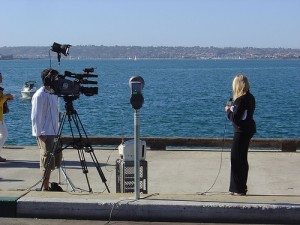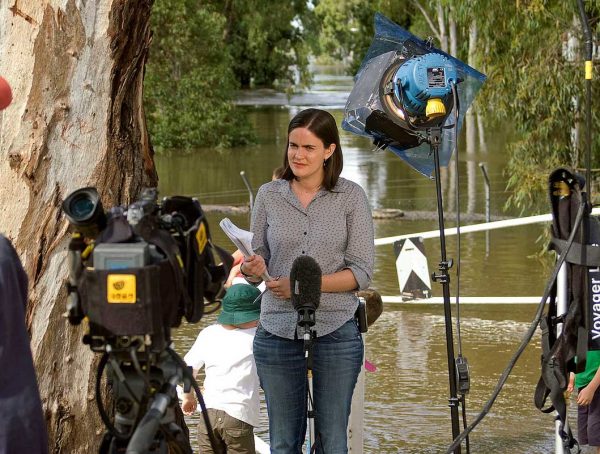 Love them or hate them, TV reporters have to do stand-ups. A stand-up can help to establish a reporter’s credibility and build a relationship with viewers, giving them a face to put with the voice. The trouble is, too many stand-ups today go overboard with unmotivated movement, cheesy props or “reporter involvement,” in an effort to add interest.
Love them or hate them, TV reporters have to do stand-ups. A stand-up can help to establish a reporter’s credibility and build a relationship with viewers, giving them a face to put with the voice. The trouble is, too many stand-ups today go overboard with unmotivated movement, cheesy props or “reporter involvement,” in an effort to add interest.
Stand-ups can be an effective way of explaining complicated issues or concepts, especially if you can find a simple analogy to illustrate the point. How does a retention pond work? Kind of like a coffee filter. Show-and-tell stand-ups can compensate for a lack of video. Where did the children first see the bear? Right here, next to this tree. These kinds of stand-ups aren’t for every story, every day, but used judiciously, they can help viewers make sense of difficult subjects.
They key word is “judiciously.” Joanne Stevens of Stevens Media Consulting says it’s important to remember that a stand-up is not all about you. “More and more I feel I’m being distracted by reporter stand-ups rather than being further edified about the story,” she writes on the RTDNA website.
You are not in a contest to bring back the most clever or viral standup. Ideally you can show us something interesting in your standup, or you may ‘just stand there’ and explain where you are and why it’s significant. You are on camera to communicate with us personally, not to assume the Shakespearean role of ‘I’m on TV and you’re not.’
Another way of adding visual interest to a longer stand-up is to shoot it in multiple takes. This allows you to walk your viewer through a complex process by illustrating individual steps in a visual sequence. Create a simple storyboard in advance to ensure that you’ll have everything you need for editing purposes.
Can you do this as a solo journalist? Absolutely. KUSA’s Kevin Torres does it all the time. The short stand-up in this package is made up of three shots, all framed differently:
“Try to add some natural sound in your stand-ups,” Torres suggests. “This helps break up the piece a lot and helps with the flow.”
Too many stand-ups are an afterthought, thrown together at the end of a shoot just to get something in the can. A stand-up should be an essential part of your narrative, adding new information and moving the story forward. A little forethought and some critical questions can make all the difference:
- Why would I want to include a stand-up in this story?
- What information would I convey in a stand-up?
- Do I have something to show or demonstrate in this stand-up?
- Where and when might I do this stand-up?
- How will the stand-up fit into the finished story?
Before you shoot any stand-up you need a clear idea of your story structure—not a complete script but a mental outline. Sometimes, it’s helpful to shoot more than one version in case that structure changes. But if you wind up with a stand-up that really doesn’t fit, resist the temptation to use it anyway. Then promise yourself that tomorrow, you’ll plan and execute a stand-up that really works.









4 Comments
[…] nice article from the News Lab about how to produce more effective stand ups. Take a look at the PKG on the page and notice the reporter’s stand up. BTW: He was working […]
[…] the results. However, I was so happy because it was the first package in which I actually used a Stand Up that I recorded. In my first packages I shot Stand Ups, but I did not use them because they did not […]